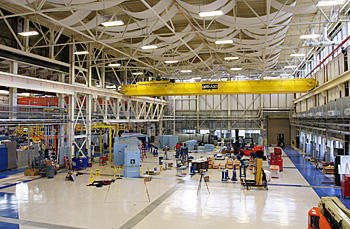
This photo of the NIST Center for Neutron Research's guide hall expansion area shows two new beamlines enclosed in protective shielding (blue structures directly under left end of yellow crane) as well as two others whose shielding is not yet completed (to the right of the enclosed beamlines). A fifth beamline, not visible, is under construction. Many new instruments will occupy the expansion's remaining area, allowing 500 more researchers per year to conduct research.
With the opening of the new guide hall addition at the National Institute of Standards and Technology's Center for Neutron Research (NCNR), neutron scientists will have nearly twice as much space to pursue their research, and will be within three months of having greatly expanded research capabilities as well.
The new guide hall, which adds an additional 16,000 square feet of space to the 20,000 square feet of the original building, will provide room for new instrumentation that will increase the NCNR's measurement capacity by more than 25 percent. The expansion will enable the facility to serve an additional 500 researchers each year. Its five new beamlines will provide "cold" neutrons for instruments that will give scientists the ability to perform neutron research that was either previously unavailable at the NCNR or possible only in limited ways.
Four of these beamlines will be ready by Oct. 1, 2012, for the installation of new instruments, several of which will come online by the end of 2012. One of these will be ready for use shortly after opening day—a new reflectometer called MAGIK. This device is designed to explore thin films having nanopatterned surfaces made of magnetic materials that can be used in data storage. The reflectometer will enable researchers to investigate the different layers of these films and the roughness of their surfaces, key factors in their performance. (An older reflectometer with more limited capability also will come back online at this time with twice its previous performance.)
According to the NCNR's Richard Ibberson, the new guide hall will also help optimize the NCNR's use of space. "As old and new devices are installed in coming weeks, we will be able to put sensitive devices like our neutron spin echo instrument in more isolated places where they will not be disturbed by nearby magnetic fields, for example," he says. "We'll be able to do more research more effectively."
The NCNR, a major national user facility, provides intense beams of neutrons used in a variety of measurement techniques, which provide otherwise unavailable information on the structure and dynamics of materials important in engineering, biology, materials science, chemistry and physics. More than 2,300 researchers from industry, academia and government participate in research at the facility each year.

